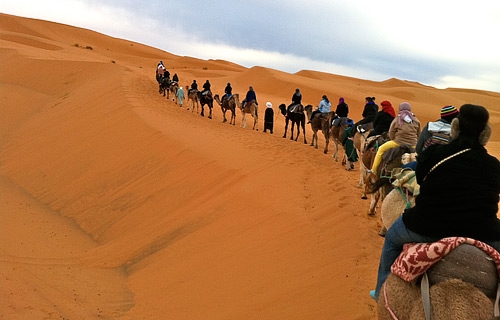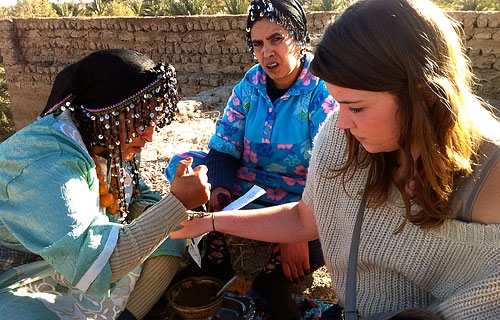Dances and Music of Morocco
February 28, 2011

“My Winter Term trip to Morocco was truly a once-in-a-lifetime opportunity,” says Megan “Meg” A. Benedict ’13. “I learned so much from being there. Now, I have firsthand knowledge of another culture’s music and traditions, which I hope to incorporate into my classroom as a teacher one day.”
Dances and Music of Morocco – a new Winter Term trip that was offered this year – was designed and led by Mary P. Kertzman, professor of physics and astronomy. She and Linda Martin, former coordinator of English language support and part-time instructor of English, along with 19 students explored three different regions of the North African country – Fez, the Sahara Desert and Marrakech.
Before leaving campus, students spent classroom time studying the geography and history of Morocco. Kertzman invited several colleagues from out of state to share their expertise of Moroccan music and dance – via Skype.
Kertzman, a belly dancer, has been to Morocco several times with a dance group, learning traditional dances. She became acquainted with the tour guide and decided to work with him during the Winter Term trip. He was able to arrange special dance performances for the DePauw students.
“We heard a lot of amazing music,” Kertzman says. “Every night, two or three groups of musicians performed for the students. One evening, our guide invited a dancer (to join us) who doesn’t normally perform for tourists. It was exceptional that we got to see her because it’s not something that’s done for tourists, but for the local community. She danced a special traditional dance called the Guedra, which is not a common dance form.”

Emily A. Brelage ’13 realizes that she was very fortunate to experience the performance. “The Guedra is a ritual dance during which an area is blessed with peace and spiritual love. While it's rare for tourists to even witness the Guedra performed, we were taught some of the dance movements. It was amazing that although few students on our trip spoke much Arabic, it was clear that music and dance transcend language barriers,” Brelage says.
Most students agreed that their stay in the Sahara Desert was another unique part of the trip. “The physical beauty of the Sahara is just incredible,” Kertzman says. “Pictures can’t do it justice. There are towering mounds of sand, and everyone fell in love with the dunes.”
Gwendolen “Gwen” L. Eberts ’13 says, “We slept in tents for four nights, played in drum circles, talked around a fire and enjoyed local music. One of the best parts of our desert stay, however, was riding on camels to watch the sunset. It was absolutely gorgeous!”
Brelage agrees. “Our visit to the Tafilalt Oasis in the Western Sahara was my favorite,” she says. “We woke up with the sunrise and rode camels across sand dunes. It was an amazing life experience.”

Students also had the extraordinary experience to witness the Call to Prayer in Fez. “We went to the top of a hill and had a panoramic view overlooking the city of Fez,” Benedict says. “While we were eating a picnic lunch, the Call to Prayer started. It is a haunting melody sung five times a day to alert people that it's time to pray. The singers have a basic melody, but they improvise variations of it. It was beautiful.”
Eberts says, “This Winter Term was one of the best trips I have ever had. The people were wonderful, and the landscapes dazzling.”
Kertzman plans to offer the trip again during Winter Term 2013.
Winter Term takes place each January between fall and spring semesters. It reflects DePauw's serious commitment to nontraditional, experiential learning. Winter Term is a time of adventurous, intellectual exploration in an atmosphere with a reduced emphasis on grades.